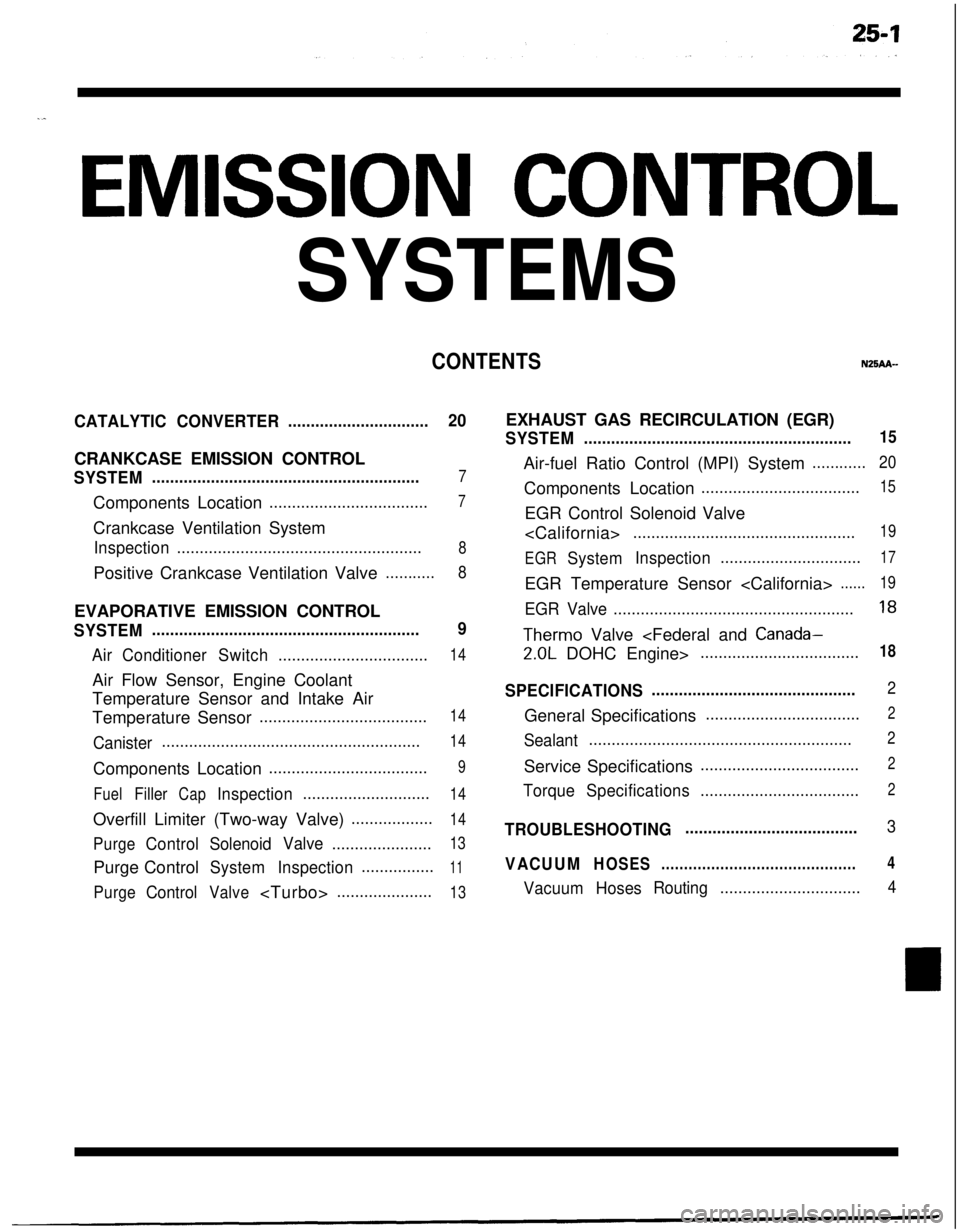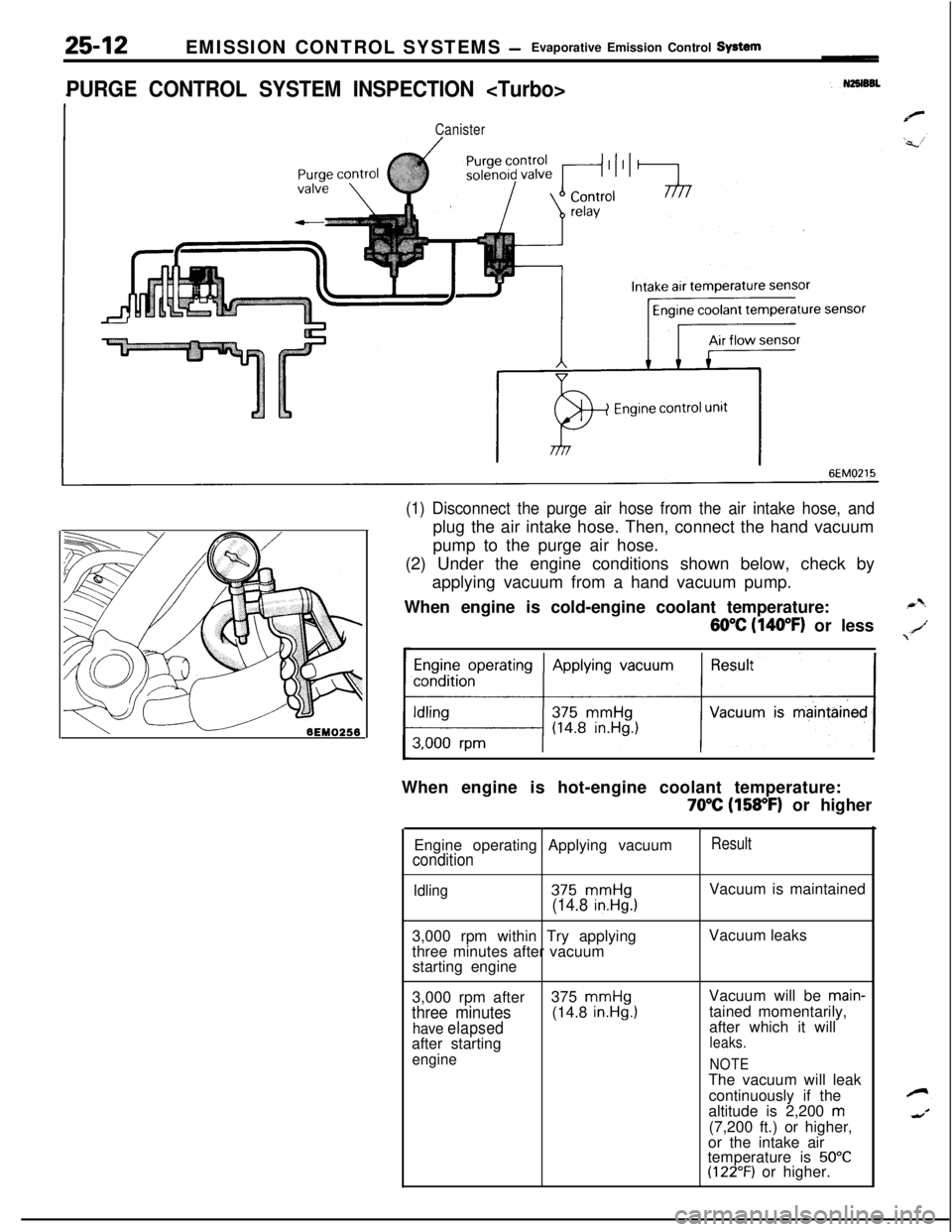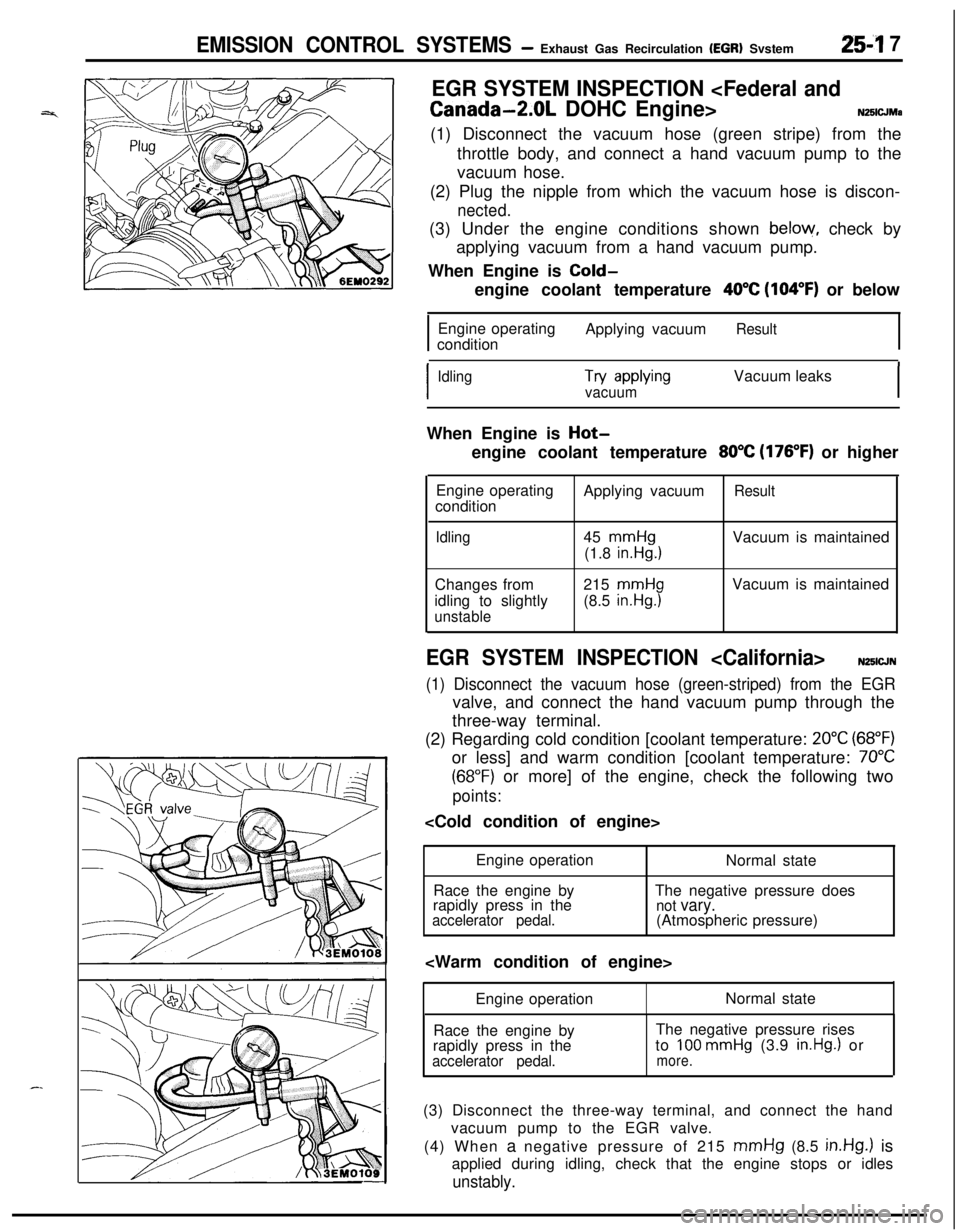coolant MITSUBISHI ECLIPSE 1991 Manual PDF
[x] Cancel search | Manufacturer: MITSUBISHI, Model Year: 1991, Model line: ECLIPSE, Model: MITSUBISHI ECLIPSE 1991Pages: 1216, PDF Size: 67.42 MB
Page 1197 of 1216

.^
EMISSION CONTROL
SYSTEMS
CONTENTSN25AA-
CATALYTICCONVERTER...............................20CRANKCASE EMISSION CONTROL
SYSTEM...........................................................7Components Location
...................................7Crankcase Ventilation System
Inspection......................................................8Positive Crankcase Ventilation Valve
...........8EVAPORATIVE EMISSION CONTROL
SYSTEM...........................................................9
AirConditionerSwitch.................................14Air Flow Sensor, Engine Coolant
Temperature Sensor and Intake Air
Temperature Sensor
.....................................14
Canister.........................................................14Components Location
...................................9
FuelFillerCapInspection............................14Overfill Limiter (Two-way Valve)
..................14
PurgeControlSolenoidValve......................13Purge Control
SystemInspection................11
PurgeControlValve
SYSTEM...........................................................15Air-fuel Ratio Control (MPI) System
............20Components Location
...................................15EGR Control Solenoid Valve
.................................................19
EGR
SystemInspection...............................17EGR Temperature Sensor
......19
EGR Valve.....................................................18
Therm0 Valve
SPECIFICATIONS.............................................2General Specifications
..................................2
Sealant..........................................................2Service Specifications
...................................2
TorqueSpecifications...................................2
TROUBLESHOOTING......................................3
VACUUMHOSES...........................................4
VacuumHosesRouting...............................4
Page 1207 of 1216

EMISSION CONTROL SYSTEMS- Evaporative Emission Control SYStem25-m
PURGE CONTROL SYSTEM INSPECTION
sensor
P+
Engine control unit
IlEM0086(1) Disconnect the vacuum hose (red stripes) from the throttle
body and connect it to a hand vacuum pump.
(2) Plug the nipple from which the vacuum hose is discon-
nected.(3) Under the engine conditions shown below, check by
applying vacuum from a hand vacuum pump.
When engine is cold-engine coolant temperature:
60% (140°F) or less
Engine operating Applying vacuum
>When engine is hot-engine coolant temperature:
70°C (158°F) or higher
Engine operating
condition
Idling3,000 rpm within
three minutes afterstarting engine
3,000 rpm after
three minutes
have elapsedafter starting
engineApplying vacuum
375
mmHg(14.8 in.Hg.1
Try wpMwvacuum375
mmHg(14.8 in.Hg.1
ResultVacuum is maintained
Vacuum leaks
Vacuum will be main-
tained momentarily,
after which it will
leaks.
NOTEThe vacuum will leak
continuously if the
altitude is 2,200
m(7,200 ft.) or higher,or the intake air
temperature is
50°C(122°F) or higher.
Page 1208 of 1216

25-12EMISSION CONTROL SYSTEMS -Evaporative Emission Control System
PURGE CONTROL SYSTEM INSPECTION
Canister
6EM0215
(1) Disconnect the purge air hose from the air intake hose, andplug the air intake hose. Then, connect the hand vacuum
pump to the purge air hose.
(2) Under the engine conditions shown below, check by
applying vacuum from a hand vacuum pump.
When engine is cold-engine coolant temperature:
60°C (140°F) or less
Engine operating Applying vacuum
11When engine is hot-engine coolant temperature:
70°C (158°F) or higher
Engine operating Applying vacuum
condition
Result
Idling375 mmHg(14.8 in.Hg.)Vacuum is maintained
3,000 rpm within Try applying
three minutes after vacuum
starting engineVacuum leaks
3,000 rpm after375
mmHgVacuum will be main-
three minutes(14.8 in.Hg.1tained momentarily,
have elapsedafter which it will
after startingleaks.
engineNOTEThe vacuum will leak
continuously if the
altitude is 2,200
m(7,200 ft.) or higher,
or the intake air
temperature is
50°C(122°F) or higher.
Page 1210 of 1216
![MITSUBISHI ECLIPSE 1991 Manual PDF 25-14EMISSION CONTROL SYSTEMS- Evaporative Emission Control System
(5) Measure the resistance between the terminals of the
solenoid valve.
Standard value: 36-44
Q [at 20°C (68OF)]_
6EM137
AIR FLOW S MITSUBISHI ECLIPSE 1991 Manual PDF 25-14EMISSION CONTROL SYSTEMS- Evaporative Emission Control System
(5) Measure the resistance between the terminals of the
solenoid valve.
Standard value: 36-44
Q [at 20°C (68OF)]_
6EM137
AIR FLOW S](/img/19/57104/w960_57104-1209.png)
25-14EMISSION CONTROL SYSTEMS- Evaporative Emission Control System
(5) Measure the resistance between the terminals of the
solenoid valve.
Standard value: 36-44
Q [at 20°C (68OF)]_
6EM137
AIR FLOW SENSOR, ENGINE COOLANT TEMPER-
ATURE SENSOR AND INTAKE AIR TEMPERA-
TURE SENSORTo inspect these parts, refer to GROUP
14-MPI System
Components.‘.
AIR CONDITIONER SWITCHTo inspect the air conditioner switch, refer to GROUP
24’--AirConditioner Switch.
OVERFILL LIMITER (TWO-WAY VALVE)N2BlBE&To inspect the overfill limiter (two-way valve), refer to GROUP
14-Fuel Tank.
CANISTERNzslBmTo inspect the canister, refer to GROUP
14-Fuel Line and
Vapor Line.
FUEL FILLER CAP INSPECTIONNZSIBJACheck the gasket of the fuel filler cap, and, the filler cap itself,
for damage or deformation; replace the cap if necessary.
Page 1213 of 1216

EMISSION CONTROL SYSTEMS- Exhaust Gas Recirculation (EGR) Svstem254 7
EGR SYSTEM INSPECTION
throttle body, and connect a hand vacuum pump to the
vacuum hose.
(2) Plug the nipple from which the vacuum hose is discon-
nected.(3) Under the engine conditions shown
below, check by
applying vacuum from a hand vacuum pump.
When Engine is
Cold-engine coolant temperature
40°C (104°F) or below
Engine operating
conditionApplying vacuum
Result
I
IdlingTry awMngVacuum leaksvacuumIWhen Engine is
Hot-engine coolant temperature
80°C (176°F) or higher
Engine operating
conditionApplying vacuum
Result
Idling45
mmHg(1.8
in.Hg.1Vacuum is maintained
Changes from
idling to slightly
unstable215
mmHg(8.5
in.Hg.1Vacuum is maintained
EGR SYSTEM INSPECTION
(1) Disconnect the vacuum hose (green-striped) from the EGRvalve, and connect the hand vacuum pump through the
three-way terminal.
(2) Regarding cold condition [coolant temperature:
20°C (68°F)or less] and warm condition [coolant temperature:
70°C
(68°F) or more] of the engine, check the following two
points:
Engine operation
Normal state
Race the engine byThe negative pressure does
rapidly press in the
not vary.accelerator pedal.(Atmospheric pressure)
Engine operationNormal state
Race the engine by
rapidly press in the
accelerator pedal.The negative pressure rises
to
100 mmHg (3.9 in.Hg.1 ormore.(3) Disconnect the three-way terminal, and connect the hand
vacuum pump to the EGR valve.
(4) When a negative pressure of 215
mmHg (8.5 in.Hg.) is
applied during idling, check that the engine stops or idles
unstably.